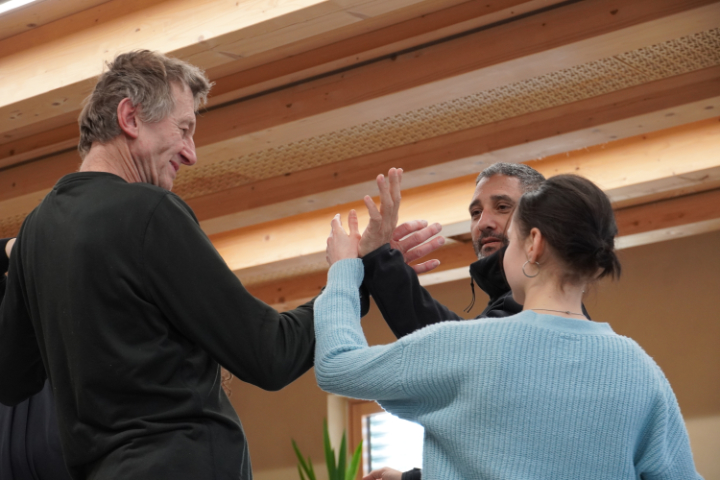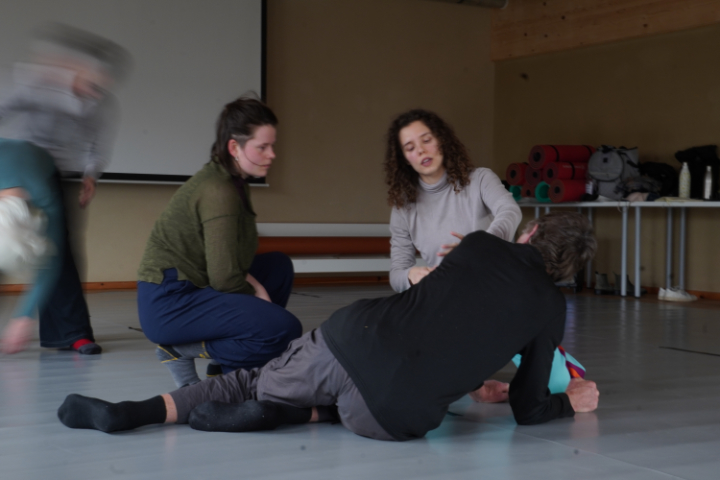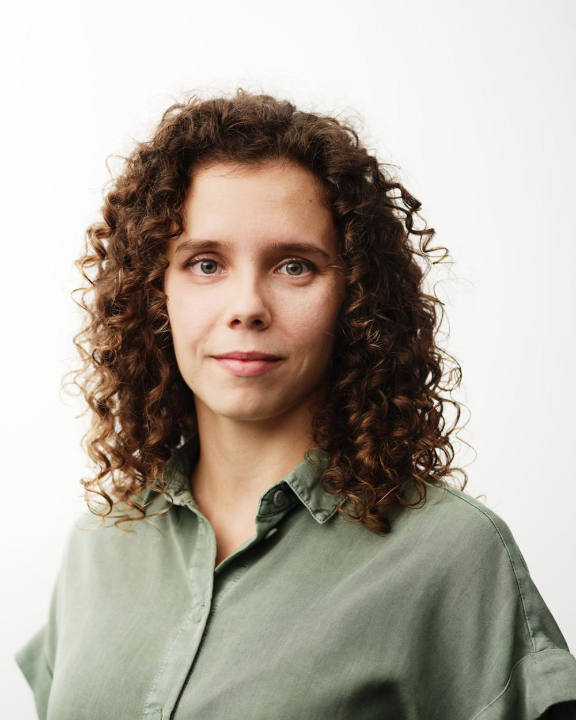 "¿Ziel:Sicher!" ist ein Doku-Tanz-Theaterprojekt von Darrel Toulon über und mit Langzeitarbeitslosen, das er gemeinsam mit Tanzstudent*innen der Anton Bruckner Privatuniversität durchführt. Die Autorin Alejandra Benet begleitete das Projekt mit einer qualitativen Studie über die Motivation der teilnehmenden Künstler*innen (in englischer Sprache).
"¿Ziel:Sicher!" ist ein Doku-Tanz-Theaterprojekt von Darrel Toulon über und mit Langzeitarbeitslosen, das er gemeinsam mit Tanzstudent*innen der Anton Bruckner Privatuniversität durchführt. Die Autorin Alejandra Benet begleitete das Projekt mit einer qualitativen Studie über die Motivation der teilnehmenden Künstler*innen (in englischer Sprache).
Vom 28. November bis zum 2. Dezember 2022 trafen sich Tanzstudenten und Gemeindemitglieder im Studio im Haus des Lernens in St. Pölten, Österreich, und arbeiteten gemeinsam. Die von Toulon geleiteten Workshops umfassten miteinander verknüpfte kollaborative Bewegungsaufgaben und künstlerische Co-Kreation.
Die nächste Phase, die zwischen Januar und Mai 2023 stattfand, bestand aus einer Reihe von dreistündigen Sonntags-Workshops, die von ABPU-Studenten geleitet wurden, mit dem Ziel, praktische Erfahrungen in der Leitung eines Gemeinschaftskunstprojekts zu sammeln.
Das "¿ZIEL:SICHER!"-Projekt wurde mit einem Symposium abgeschlossen: "¿ZIEL:SICHER!" - einer künstlerischen Dokumentation an der Anton Bruckner Privatuniversität in Linz, bei der die Ergebnisse dieser Forschung präsentiert wurden. Expert*innen und StudentInnen nahmen an dem Symposium mit wissenschaftlichen Präsentationen, künstlerischen Interventionen, Podiumsdiskussionen und Performances teil. Außerdem wurde ein Film über die das Projekt und seine Teilnehmer*innen Film über die das Projekt und seine Teilnehmer*innen vorgestellt.
 Motivational factors of dance artists engaging in the community arts project “¿Ziel:Sicher!”
Motivational factors of dance artists engaging in the community arts project “¿Ziel:Sicher!”
Introduction
Extensive research has been done on the benefits for the community members in participating in community dance. However, little research on the reasons that drive artists to engage in such projects has been conducted. Knowing how dance artists benefit from engaging with the community, what drives them to do so, is a crucial aspect for this exchange between professional dancers and community members to really be equal and reciprocal. Both must get something out of this experience, otherwise the professional dancers would be placed in a position of superiority as the ones who are helping the community, when in fact the community also contributes to the artist.
This article we will be looking at the motivations that drove the dance artists from Anton Bruckner Privatuniversität (ABPU) to participate in the community dance project “¿Ziel:Sicher!”. This biographical data provides practical and meaningful insights into specific aspects of the subject at hand.
Project Content
“¿Ziel:Sicher!” is a docu-dance-theatre[1] project directed by Darrel Toulon about and with long-term unemployed people, working alongside dance students from Anton Bruckner Privatuniversität. The dancers had 3 informative and theoretical sessions prior to the work with the community members. From the 28th of November until the 2nd of December 2022, dance students and community members met and worked together in the studio in Haus des Lernens in St. Poelten, Austria. The workshops led by Toulon involved interconnected collaborative movements tasks and artistic co-creation.
The next phase taking place between January and May 2023 consisted of a series of 3 hours Sunday workshops facilitated by ABPU students with the aim of gaining practical experience in leading a community arts project.
“¿ZIEL:SICHER!” project culminated with a Symposium: “¿ZIEL:SICHER!” – an Artistic Documentation at the Anton Bruckner Privatuniversität in Linz, where the results of this research were presented. Experts in the field and students participated in the Symposium with Academic Presentations, Artistic Interventions, Panel Discussions and Performances.
Methodology
This research contributes to and is based on the work of Mia Sophia Bilitza (2021), who identified 8 motivational factors that drive dance artists to work with the community. These 8 factors were extracted from a series of interviews with 7 expert dance facilitators, and divided in 3 categories. First, an artistic motivation for choreographing and working with heterogeneous groups; second, a visionary motivation in terms of social change and society, and third, a personal or private motivation.
This research is an ethnographic study on the seven dance students participating in the project “¿ZIEL:SICHER!” looking into their motivations, as dance artists, to engage in community dance. After observing and listening to the dance participants during the development whole project in its different phases, the dancers were asked to filled a questionnaire and participate in an individual interview. The questionnaire was developed based on Bilitza’s findings (2021). Dancers had to choose between a scale of one (strongly disagree) to five (strongly agree) according to their agreement to the motivational statement. After filling the questionnaire, a recorded interview was hold with the dancers individually to discuss their answers.
|
CATEGORY |
MOTIVATIONAL STATEMENT |
|
Artistic motivation for choreographing and working with differently abled and heterogeneous groups. |
“My motivation lies in working with the physical differences of the participants as creative input for choreographing and creating artistic work.” |
|
“My motivation lies in creating an opportunity for transformation or the “moment of disclosure”: the moment when participants are suddenly able to follow a movement or instruction at an unusually high level of quality and when they discover their ability to use their own body as an instrument.” |
|
|
Visionary motivation in terms of society and social change. |
“My motivation lies in working with non-professional participants’ boundless energy and enthusiasm.” |
|
“My motivation lies in creating the space for personal growth and change of behaviors towards oneself and the others, or when dealing with challenges.” |
|
|
“My motivation lies in inclusion, and in a belief in participation for all people in arts.” |
|
|
“My motivation lies in doing something that “makes sense” in a wider social scale.” |
|
|
“My motivation lies in bringing people together, encouraging interaction, reflection, exchange and further empathy between people by means of the work.” |
|
|
Personal or private motivation for working with a specialized group of people. |
“My motivation lies in personal or private factors: general interest in people, self-fulfillment (of the dancer), personal and professional growth (of the dancer).” |
The aim of this research is to present patterns of thoughts among the dance participants, regarding their motivations to engage in community dance, supported by their testimonies. The motivational factors will be presented in order of highest concurrence to the lowest among all the interviewees.
Results and Discussion
|
“My motivation lies in bringing people together, encouraging interaction, reflection, exchange and further empathy between people by means of the work” |
All seven dancers agreed with this motivational statement. In the discussions with the dancers, there was also an acknowledgement that through the framework of a practice, social engagement can be boosted. It is easier to bring people into interaction and involve them in a framework of a task, especially when they are suffering from isolation. The testimony below brings into attention that dance is also a community ritual. Humans have always danced, regardless of culture, time and place.
According to French sociologist Emile Durkheim, dance is a social practice that cultivates what he called “collective effervescence”, and creates communal feelings that are needed for gluing societies together. “Collective effervescence refers to the considerably amplified emotional state manifested by the participants of a collective assembly because of their experience of shared emotions and the ensuing reciprocal emotional activation” (Rimé & Páez, 2023, p. 16).
Participant’s testimony:
“Dance is all about bringing people together. It was from the beginning of the history of dance. It had ritualistic purposes, asking for rain, being in a community, etc. So from the beginning, dance is something spiritual and something that people were doing to get to be together”.
|
"My motivation lies in creating the space for personal growth and change of behaviors towards oneself and the others, or when dealing with challenges" |
Six out of seven dancers agreed with this statement.
The testimony below expresses how we use the body, creates potentially positive and constructive experiences for the mind and brain. Movement routines allow to cultivate mindsets associated with psychological improvement.
Participant’s testimony:
I do believe that movement and dance can enable a different way of dealing with personal things and can enable a different kind of growth that maybe isn't possible through only using words. I feel there's something magical that at this point in my life I am still not able to grasp what exactly that is with movement. But I just see and I can feel and observe in different contexts that there is something magical that enables growth through being in connection with the body and moving things, like not only “moving” as in movement, but moving inner processes.
|
"My motivation lies in personal or private factors: general interest in people, my own self-fulfillment (of the dancer), my personal and/or professional growth (of the dancer)" |
Six out of seven dancers agreed with this motivational statement. There was a shared view among the dancers that encountering and understanding how other people see the world brings emotional growth.
Participant’s testimony:
I really feel like it enriches my dancing profession. I had a moment when I was choosing between different pathways where I thought, but if I'm not going to be a full-time dancer now, and if I take time for all of these other things, then where am I going to be as an artist or dancer? And of course, there is a limit because as I'm doing a lot of other things now, maybe I will never become as skilled as I could be if I would train 8 hours a day every day. But I feel like I have a different kind of maturity now when I go on stage and I have a different kind of maturity when I think about what I want to say artistically.
|
"My motivation lies in inclusion, and in a belief in participation for all people in arts" |
Five out of seven dancers agreed with this statement. Regarding the element of “inclusion”, there was an interesting reflection from one of the dancers. She wished that we wouldn’t need to talk about inclusion, because it would mean that the normative way is that everybody is included. And this shows that the obstacle is systemic and structural.
Regarding “participation”, they agreed that arts is there for everyone to experience. However, they raised questions on and pointed out at the difference between participation and professionalization. If anyone can be a performer, what would this make out of their profession.
Nevertheless, there are many ways of participating in a creative process, besides the role of perfomer. This decision is project-specific, and the concept will define what sort of involvement and profiles it needs, whether it is professional trained dancers, or community dancers, or both.
|
“My motivation lies in doing something that “makes sense” in a wider social scale” |
Five out of seven dancers agreed with this statement.
Participant’s testimony:
I think that it is important to do something that has some meaning behind it, for us, for me, for the people who are in the project, for people who are watching… I think every art can do something that makes sense in a wider social scale. But because of the people who are in this project, I think that's what makes it make sense and that's what makes it mean something.
|
“My motivation lies in creating an opportunity for transformation or the “moment of disclosure”: the moment when participants are suddenly able to follow a movement or instruction at an unusually high level of quality and when they discover their ability to use their own body as an instrument.” |
Five out of seven dancers agreed with this statement. Among the dancers, there were observations on the difference between community participants, who keep this fresh excitement for what they are doing, and professional dancers, whose excitation has lowered from the moment that dance becomes their work. And there was an emphasis on doing this sort of work for generating interest, as an invitation for self-achievements.
Participant’s testimony:
“My motivation lies in creating an opportunity for”. It is not that it will happen, but the opportunity is there. The possibility is there in the space that it can happen. This is what I understood, and I think I would love to create space for it to happen, if it's possible. “They discover their ability to use their own body as an instrument”, and they find “an unusually high level of quality” for them. For them, it's unusually high compared to what they have experienced before. And I think these are kind of pillars of learning. And they don't need to be extraordinary changes. Changes contribute to learning, because once you have a change, you realize that this is something new. You may not understand what but it was interesting, it's new, it's exciting, I want to explore it again.
|
“My motivation lies in working with non-professional participants’ boundless energy and enthusiasm” |
Five out of seven dancers agreed with this factor. Some of the artists shared that do not expect participants to be excited about the project necessarily. Some artists pointed out that simply because dance is their medium to express themselves, that doesn’t mean it has to be the medium for everybody else, and community members are free to choose the activity that best suits them.
Participant’s testimony:
I feel like that it's their choice. I don't want to motivate anyone to be interested in what I'm doing. I don't want to give the impression that art is great, what I'm doing is great, you should be interested in it. It's their choice. And already if I know that they agreed to participate in something that I or someone had to offer, they are already interested in it enough to just be there and it's already something and I think that's enough.
|
“My motivation lies in working with the physical differences of the participants as creative input for choreographing and creating artistic work” |
Two out of seven dancers agreed with this statement. I observed that these dancers had in interest in the functionality of the body and the diverse ways in which a movement can be performed or executed. They felt inspired by looking at how others move.
Participant’s testimony:
A creative process should always include the physical differences or the state of arrival of the people that you are wanting to create with. So for me, physical differences are a chance to generate something new and to find new places, new movements, new stories, which is why I think it's very important for me to work with what is there on a physical level.
Conclusion
From the dancers’ perspective who participated in the project “¿Ziel:Sicher!”, the conclusion we can draw is that: (1) dance community work strengthens social ties, (2) it helps to overcome psychological barriers of both the artist and community members, (3) by engaging in community arts, the artists get out of their own bubble, preventing their artistic work from becoming detached or isolated from reality, and (4) it could even inspire further projects and creations.
More research on the motivations of dancers to work with community members, and how they benefit from it needs to be conducted in order to enhance our understanding of this matter.
Dancers share the same language, images, codes of expression… this analysis suggests that by meeting non-professionals, dancer encounter other ways of constructing meaning and this enriches them. By looking at how the dancer is impacted from working in projects such the one at study in this research, we reach the conclusion that the dancer learns from the community, the same wat that the community learns from the dancer.
References
Bilitza, M. S. (2021). Being the Facilitator: A Brief Research Report on the Motivation of the Choreographer and Dance Maker to Work With Heterogeneous Groups in a Community Dance Setting. Frontiers in Psychology, 12, 601033.
Rimé, B., & Páez, D. (2023). Why We Gather: A New Look, Empirically Documented, at Émile Durkheim’s Theory of Collective Assemblies and Collective Effervescence. Perspectives on Psychological Science, 174569162211463.
Ethics Statement
The participants provided their written informed consent to participate in this study. Written informed consent was obtained from the participants for the publication of any identifiable data included in this article.
Acknowledgment
Special thanks go to the participants for their time and their openness to share their thoughts and to speak about their motivations. Thank you as well to Darrel Toulon for his support.
 Alejandra Benet (ES / USA)
Alejandra Benet (ES / USA)
is a performance and dance artist, researcher and curator. The interchange interaction between her practice in these roles nurtures her work as creator, which give rise to experimental, forward thinking, and conceptually thorough and diverse work. She holds a MA in Movement Research and a MA in Pedagogy from the Anton Bruckner Privatuniversität, and a BsC in International Politics from City University of London. She is also a RAD Teacher and a GYROTONIC® licensed trainer. https://alejandrabenet.com
[1] Docu-dance-theatre is a performance genre developed by Darrel Toulon that departs from Documentary Theatre, using personal narratives as a text source, obtained through Verbatim methods. For further information visit https://www.the-alpha-group.org/docu-dance-theater/
